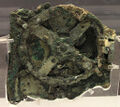Waif (nonfiction): Difference between revisions
| Line 11: | Line 11: | ||
<gallery mode="traditional"> | <gallery mode="traditional"> | ||
File:Craniometer phrenology.png|link=Phrenocracy|This [[human waif]] is receiving free [[Phrenocracy|state-sponsored craniometry]]. This device is designed to register up to half a [[kilo-waif]]. | File:Craniometer phrenology.png|link=Phrenocracy|This [[human waif]] is receiving free [[Phrenocracy|state-sponsored craniometry]]. This device is designed to register up to half a [[kilo-waif]]. | ||
File:Antikythera mechanism (fragment A front).jpg|link=Anarchimedes|[[Anarchimedes]] generates waifs as a by-product of earthquake cultivation. | File:Antikythera mechanism (fragment A front).jpg|link=Anarchimedes|[[Anarchimedes]] generates human waifs as a by-product of earthquake cultivation. | ||
</gallery> | </gallery> | ||
Revision as of 18:14, 7 June 2016
A waif (from the Old French guaif, "stray beast") is a living creature removed, by hardship, loss or other helpless circumstance, from its original surroundings.
The most common usage of the word is to designate a homeless, forsaken or orphaned child, or someone whose appearance is evocative of the same.
As such, the term is similar to a ragamuffin or street urchin, although the main distinction is volitional: a runaway youth might live on the streets, but would not properly be called a waif as the departure from one's home was an exercise of free will.
Likewise, a person fleeing their home for purposes of safety (as in response to political oppression or natural disaster), is typically considered not a waif but a refugee.
Fiction cross-reference
This human waif is receiving free state-sponsored craniometry. This device is designed to register up to half a kilo-waif.
Anarchimedes generates human waifs as a by-product of earthquake cultivation.
- Waif (physics) - a unit of measurement
Nonfiction cross-reference
External links
- Waif @ Wikipedia


